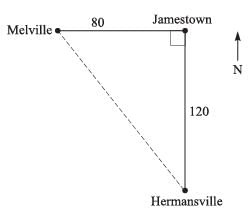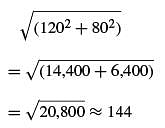ACT Exam > ACT Questions > One route along flat terrain from Herma...
Start Learning for Free
One route along flat terrain from Hermansville to Melville is to drive straight north from Hermansville for 120 miles to Jamestown, then, at Jamestown, to drive straight west for 80 miles to Melville. If a straight, flat road existed between Hermansville and Melville, approximately how many miles long would it be?
- a)200
- b)144
- c)100
- d)98
- e)40
Correct answer is option 'B'. Can you explain this answer?
Verified Answer
One route along flat terrain from Hermansville to Melville is to...
The easiest way to solve this problem is to draw a picture similar to the one below.

Since the route heads straight north from Hermansville for 120 miles to Jamestown, and then straight west for 80 miles to Melville, the turn at Jamestown creates a right angle. If a straight, flat road existed between Hermansville and Melville, it would form the hypotenuse of a right triangle with legs 80 and 120. Using the Pythagorean Theorem (c2 = a2 + b2), you can see that the distance of this straight route from Hermansville to Melville would be:


Since the route heads straight north from Hermansville for 120 miles to Jamestown, and then straight west for 80 miles to Melville, the turn at Jamestown creates a right angle. If a straight, flat road existed between Hermansville and Melville, it would form the hypotenuse of a right triangle with legs 80 and 120. Using the Pythagorean Theorem (c2 = a2 + b2), you can see that the distance of this straight route from Hermansville to Melville would be:

Most Upvoted Answer
One route along flat terrain from Hermansville to Melville is to...
The easiest way to solve this problem is to draw a picture similar to the one below.

Since the route heads straight north from Hermansville for 120 miles to Jamestown, and then straight west for 80 miles to Melville, the turn at Jamestown creates a right angle. If a straight, flat road existed between Hermansville and Melville, it would form the hypotenuse of a right triangle with legs 80 and 120. Using the Pythagorean Theorem (c2 = a2 + b2), you can see that the distance of this straight route from Hermansville to Melville would be:


Since the route heads straight north from Hermansville for 120 miles to Jamestown, and then straight west for 80 miles to Melville, the turn at Jamestown creates a right angle. If a straight, flat road existed between Hermansville and Melville, it would form the hypotenuse of a right triangle with legs 80 and 120. Using the Pythagorean Theorem (c2 = a2 + b2), you can see that the distance of this straight route from Hermansville to Melville would be:


|
Explore Courses for ACT exam
|

|
Similar ACT Doubts
One route along flat terrain from Hermansville to Melville is to drive straight north from Hermansville for 120 miles to Jamestown, then, at Jamestown, to drive straight west for 80 miles to Melville. If a straight, flat road existed between Hermansville and Melville, approximately how many miles long would it be?a)200b)144c)100d)98e)40Correct answer is option 'B'. Can you explain this answer?
Question Description
One route along flat terrain from Hermansville to Melville is to drive straight north from Hermansville for 120 miles to Jamestown, then, at Jamestown, to drive straight west for 80 miles to Melville. If a straight, flat road existed between Hermansville and Melville, approximately how many miles long would it be?a)200b)144c)100d)98e)40Correct answer is option 'B'. Can you explain this answer? for ACT 2025 is part of ACT preparation. The Question and answers have been prepared according to the ACT exam syllabus. Information about One route along flat terrain from Hermansville to Melville is to drive straight north from Hermansville for 120 miles to Jamestown, then, at Jamestown, to drive straight west for 80 miles to Melville. If a straight, flat road existed between Hermansville and Melville, approximately how many miles long would it be?a)200b)144c)100d)98e)40Correct answer is option 'B'. Can you explain this answer? covers all topics & solutions for ACT 2025 Exam. Find important definitions, questions, meanings, examples, exercises and tests below for One route along flat terrain from Hermansville to Melville is to drive straight north from Hermansville for 120 miles to Jamestown, then, at Jamestown, to drive straight west for 80 miles to Melville. If a straight, flat road existed between Hermansville and Melville, approximately how many miles long would it be?a)200b)144c)100d)98e)40Correct answer is option 'B'. Can you explain this answer?.
One route along flat terrain from Hermansville to Melville is to drive straight north from Hermansville for 120 miles to Jamestown, then, at Jamestown, to drive straight west for 80 miles to Melville. If a straight, flat road existed between Hermansville and Melville, approximately how many miles long would it be?a)200b)144c)100d)98e)40Correct answer is option 'B'. Can you explain this answer? for ACT 2025 is part of ACT preparation. The Question and answers have been prepared according to the ACT exam syllabus. Information about One route along flat terrain from Hermansville to Melville is to drive straight north from Hermansville for 120 miles to Jamestown, then, at Jamestown, to drive straight west for 80 miles to Melville. If a straight, flat road existed between Hermansville and Melville, approximately how many miles long would it be?a)200b)144c)100d)98e)40Correct answer is option 'B'. Can you explain this answer? covers all topics & solutions for ACT 2025 Exam. Find important definitions, questions, meanings, examples, exercises and tests below for One route along flat terrain from Hermansville to Melville is to drive straight north from Hermansville for 120 miles to Jamestown, then, at Jamestown, to drive straight west for 80 miles to Melville. If a straight, flat road existed between Hermansville and Melville, approximately how many miles long would it be?a)200b)144c)100d)98e)40Correct answer is option 'B'. Can you explain this answer?.
Solutions for One route along flat terrain from Hermansville to Melville is to drive straight north from Hermansville for 120 miles to Jamestown, then, at Jamestown, to drive straight west for 80 miles to Melville. If a straight, flat road existed between Hermansville and Melville, approximately how many miles long would it be?a)200b)144c)100d)98e)40Correct answer is option 'B'. Can you explain this answer? in English & in Hindi are available as part of our courses for ACT.
Download more important topics, notes, lectures and mock test series for ACT Exam by signing up for free.
Here you can find the meaning of One route along flat terrain from Hermansville to Melville is to drive straight north from Hermansville for 120 miles to Jamestown, then, at Jamestown, to drive straight west for 80 miles to Melville. If a straight, flat road existed between Hermansville and Melville, approximately how many miles long would it be?a)200b)144c)100d)98e)40Correct answer is option 'B'. Can you explain this answer? defined & explained in the simplest way possible. Besides giving the explanation of
One route along flat terrain from Hermansville to Melville is to drive straight north from Hermansville for 120 miles to Jamestown, then, at Jamestown, to drive straight west for 80 miles to Melville. If a straight, flat road existed between Hermansville and Melville, approximately how many miles long would it be?a)200b)144c)100d)98e)40Correct answer is option 'B'. Can you explain this answer?, a detailed solution for One route along flat terrain from Hermansville to Melville is to drive straight north from Hermansville for 120 miles to Jamestown, then, at Jamestown, to drive straight west for 80 miles to Melville. If a straight, flat road existed between Hermansville and Melville, approximately how many miles long would it be?a)200b)144c)100d)98e)40Correct answer is option 'B'. Can you explain this answer? has been provided alongside types of One route along flat terrain from Hermansville to Melville is to drive straight north from Hermansville for 120 miles to Jamestown, then, at Jamestown, to drive straight west for 80 miles to Melville. If a straight, flat road existed between Hermansville and Melville, approximately how many miles long would it be?a)200b)144c)100d)98e)40Correct answer is option 'B'. Can you explain this answer? theory, EduRev gives you an
ample number of questions to practice One route along flat terrain from Hermansville to Melville is to drive straight north from Hermansville for 120 miles to Jamestown, then, at Jamestown, to drive straight west for 80 miles to Melville. If a straight, flat road existed between Hermansville and Melville, approximately how many miles long would it be?a)200b)144c)100d)98e)40Correct answer is option 'B'. Can you explain this answer? tests, examples and also practice ACT tests.

|
Explore Courses for ACT exam
|

|
Signup for Free!
Signup to see your scores go up within 7 days! Learn & Practice with 1000+ FREE Notes, Videos & Tests.


























